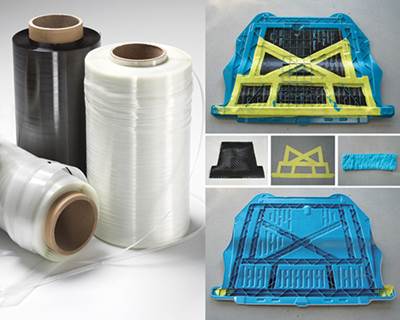Evolution of tailored D-LFT
In the past two decades, two competing composite technologies — sheet-form glass-mat thermoplastic (GMT) and pelletized long-fiber thermoplastic (LFT) — led to the development of a new form of glass-reinforced thermoplastic composite.
In the late 1990s and early 2000s two competing composite technologies — sheet-form glass-mat thermoplastic (GMT) and pelletized long-fiber thermoplastic (LFT) — led to the development of a new form of glass-reinforced thermoplastic composite.
GMT producers had been working since the 1980s to enhance the moldability of continuously reinforced, randomly oriented GMT composites, which were processed via compression molding. GMTs were very tough and relatively stiff, and they had less mass and could be processed faster than the thermoset sheet-molding compound (SMC) and metals that they commonly competed against. But as a semifinished good, traditional GMT was still costly and heavier than injection molded thermoplastics and posed significant challenges for molders who needed to fill intricate design features. The primary problem was glass bridging, which led to resin-rich areas that tended to fail before the rest of the part.
To address molding and filling issues, GMT producers experimented with discontinuous chopped-fiber products. They eventually phased out traditional continuous, randomly oriented fiber forms and settled on products whose fiber lengths (going into the tool) were on the order of 50 to 100 mm (1.97 to 3.94 inches). In situations that demanded greater stiffness and strength, their properties were further enhanced through the addition of sheets or blanks of unidirectional (UD) or fabric-reinforced GMT. This improved moldability and made GMT malleable enough for complex geometries. It also reduced cost and mass in applications where higher performance wasn't necessary, and that made the products more competitive against the rising tide of long-fiber thermoplastics.
Parallel to developments in GMT, producers of injection molded thermoplastics had been searching for ways to increase fiber length and fiber-volume fraction (FVF) to boost mechanical performance. The goal was to produce parts that could compete better in more structural applications without sacrificing the processing speeds, surface finish and finished part complexity that characterize injection molded thermoplastics.
Gradually, the glass length in precompounded resin pellets increased to 13 mm/0.51 inch, which was the maximum size that could be accommodated by the feed throat on the compounding unit of the injection molding machine. Longer fibers not only broke, but also tended to clog the equipment. In an effort to get around these limitations, inline compounding (ILC) was developed. ILC combines resin and additives at the press and brings them together with continuous-glass reinforcement (fed from large spools). The combined resin, additive and fiber mixture is immediately cut into a log or charge that is subsequently placed (manually or automatically) into an injection press and formed into parts. Later, ILC was combined with compression molding presses as well.
As GMT suppliers gave up strength and stiffness to enhance moldability and reduce mass and cost by using shorter fibers, and as injection molders sought greater strength and stiffness by incorporating longer fibers at higher fiber volumes, ILC was a technological meeting point that facilitated the direct long-fiber thermoplastics (D-LFT) process, which typically features fibers that are 20 to 40 mm/0.8 to 1.6 inches prior to molding. Further work with compression molding grades of these materials borrowed a technique from GMT producers by laying in additional blanks or charges of continuous-fiber-reinforced forms of composite with the same matrix. The technique of combining discontinuous with continuous reinforcements was developed in Europe, primarily for the automotive industry, and became known as tailored D-LFT.
Related Content
Cryo-compressed hydrogen, the best solution for storage and refueling stations?
Cryomotive’s CRYOGAS solution claims the highest storage density, lowest refueling cost and widest operating range without H2 losses while using one-fifth the carbon fiber required in compressed gas tanks.
Read MoreThe lessons behind OceanGate
Carbon fiber composites faced much criticism in the wake of the OceanGate submersible accident. CW’s publisher Jeff Sloan explains that it’s not that simple.
Read MorePlant tour: Teijin Carbon America Inc., Greenwood, S.C., U.S.
In 2018, Teijin broke ground on a facility that is reportedly the largest capacity carbon fiber line currently in existence. The line has been fully functional for nearly two years and has plenty of room for expansion.
Read MoreTU Munich develops cuboidal conformable tanks using carbon fiber composites for increased hydrogen storage
Flat tank enabling standard platform for BEV and FCEV uses thermoplastic and thermoset composites, overwrapped skeleton design in pursuit of 25% more H2 storage.
Read MoreRead Next
Hybrid thermoplastic molding: Toughening automotive composites
Tailored D-LFT with continuous and discontinuous glass offers best combination of strength, moldability.
Read MoreDeveloping bonded composite repair for ships, offshore units
Bureau Veritas and industry partners issue guidelines and pave the way for certification via StrengthBond Offshore project.
Read MoreVIDEO: High-volume processing for fiberglass components
Cannon Ergos, a company specializing in high-ton presses and equipment for composites fabrication and plastics processing, displayed automotive and industrial components at CAMX 2024.
Read More
.jpg;width=70;height=70;mode=crop)














.jpg;maxWidth=300;quality=90)









